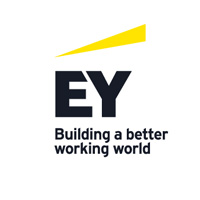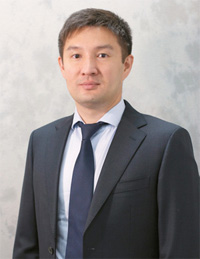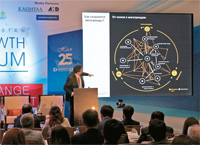KAZAKHSTAN ENERGY WEEK 2019
Trends in the Professional Development Market for Oil

The use of information technologies in the oil and gas industry
Information technologies are leverage which facilitates the development of the oil and gas industry. They raise the effectiveness of administration and management as well as reduce costs on both the development of oil and gas fields and on oil and gas transportation and refining. These technologies help oil and gas companies to streamline their production processes, raise quality, safety, and operating efficiency, accelerate market accession, as well as create new business opportunities in a more effective manner. Digital transformation of the oil and gas complex is a strategic direction for industry development, without which it would be virtually impossible to imagine its future. The ecosystem of the digital oil and gas economy is based on the collection and transmission of digital geological and production data, which is a key to the development of digitized oil and gas production.
The main digital technologies used in the oil and gas industry include the following:
 Svetlana Yakovlevа, Senior manager, EY Business Academy Business Consultant. Degrees and Certifications: MBA, CIA®, PMP®, IPMA, CIMA P1
Svetlana Yakovlevа, Senior manager, EY Business Academy Business Consultant. Degrees and Certifications: MBA, CIA®, PMP®, IPMA, CIMA P1
Business analytics
- Visualization of seismological data and the creation of 3D models of oil and gas fields
- Predictive analytics based on big data mining
Artificial intelligence (AI)
- The projection of equipment maintenance and repair based on analysis of sensor-provided data
- The streamlining of power consumption across operating regimes
Drones
- Visual monitoring of equipment to determine its wear and ensure fire safety
- The remote monitoring of oil and gas fields and management of equipment operating modes.
 Gulnar Musrepova, Manager, EY Business Academy Business Consultant, Professional Accountant of the Republic of Kazakhstan. Certifications: ACCA, DipIFR, DipIPSAS
Gulnar Musrepova, Manager, EY Business Academy Business Consultant, Professional Accountant of the Republic of Kazakhstan. Certifications: ACCA, DipIFR, DipIPSAS
The internet of things
- The monitoring of equipment conditions in real-time and remote configuration of equipment settings
- Notification of repair and spare parts needs
- The monitoring and transmission of data on well debit, water use, and oil and gas production
The development of the entire Kazakh economy hinges on the digitization of the oil and gas industry.
Agile project management methodology and effective change-management tools
Most countries are currently relying on project management methodology. Pursuant to US statistics, virtually a third of the global economy involves project management. According to the Project Management Institute, the total number of project management professionals is increasing annually. The oil and gas industry has become one of the project management trailblazers in Kazakhstan. It is part and parcel of one of the most project management-intensive economic segments and is one of the largest domestic consumers of high technology products. Companies manage projects for projecting, exploring, and developing oil and gas fields, where tasks are tackled at different stages which then turn into local projects that are connected by common goals. As of now, project management is a tested and effective tool for any type of change management. Successfully completed projects are the foundation on which a company builds its future irrespective of whether they involve the construction of buildings, development of an oil and gas field, or the introduction of a new IT system.
 Oksana Shintemirova, EY Business Academy Business Consultant. Degrees and Certifications: MBA, PMP®, Certified ISO 31000 Risk Management Professional
Oksana Shintemirova, EY Business Academy Business Consultant. Degrees and Certifications: MBA, PMP®, Certified ISO 31000 Risk Management Professional
Based on the findings of industry analysts, we perceive a trend in the life cycle of systems development towards a reduction in the time required to introduce new digital solutions. The Agile methodology pursues the objective of promptness. It provides an organization with effective and economical capabilities for a rapid adaptation to changes in market conditions, as well as other external factors, and gives it numerous advantages:
- provides the organization with the tools and techniques for accelerating results from an implementation
- allows it to mitigate the risk of deadline disruption, as the project implementation involves small iterations (sprints) with a clear understanding of each of their scopes
- raises project effectiveness by providing focus on the achievement of high-priority objectives and continuous product improvement during the project’s duration
- ensures coordinated activities of the business team and the implementation team, as well as commensurate involvement in the development process, while contributing to the development of effective communication and a sense of common responsibility for the result.
Internal control is the integral part of risk management
What is risk management about? To answer the question, it will be prudent to begin by defining the notion of risk.
- “Risk is an effect of uncertainty on objectives. An effect is a deviation from the expected.”
- “Risk is the possibility that events will occur and affect the achievement of strategy and business objectives.”

Irrespective of the source of the notion’s definition, risk is an event that can occur in the future. If an event has taken place, this is referred to as a problem. Such future event will affect objectives, both on the strategic and operating levels. It is noteworthy that these events can have both favorable consequences, or opportunities, as well as unfavorable, or threats. Unfortunately, the current practice in Kazakhstan considers threats above all.
If one proceeds from the definition of risk, one can say that risk management signifies the taking of certain actions with a view either to facilitating the realization of opportunities or the prevention of threats. However, there is also a broader definition: “risk management is coordinated activities to direct and control an organization with regard to risk.” References are often made to risk management in certain industries, however, this pertains only to the specific features of the risks themselves. For example, in the oil and gas industry they refer to the risks at the stage of acceding to a project, the stage of project implementation as well as the stage of project closure. If one approaches the matter from the viewpoint of risk management as a concept, then, irrespective of industry and the sphere of operations, one can always say that company management equals risk management, i.e. the head of a company always makes decisions taking into account possible future events that may affect the company’s objectives, that is to say, taking risks into account.
Risk management process includes the following steps:
- risk identification
- risk analysis and assessment: it is worth mentioning that the trend is slanted towards quantitative risk assessment, which, in turn, sets high requirements for risk managers
- development of preventive measures: we influence the risk causes or, even better, risk factors and reactive measures (we influence the consequences of the risk materializing)
- monitoring and control: continuous monitoring and periodic control.
 Natalya Rashitova, Manager, EY Business Academy Business Consultant. Certifications: PMP®, MBTI®, DISC®
Natalya Rashitova, Manager, EY Business Academy Business Consultant. Certifications: PMP®, MBTI®, DISC®
The application of designed preventive and reactive measures is the integral part of a company’s internal control.
Internal control is a process carried out by the board of directors, management, and other company’s employees with the objective of delivering reasonable assurance that the company’s targets can be achieved with respect to its operations, preparation of financial statements, and compliance.
Internal control is the integral part of risk management. The absence of internal control over the execution of decisions that have been adopted after a consideration of risk may result in the respective decisions not being executed and, as consequence, the company may miss its targets.
Finally, it is worth saying that the consideration of risk management and internal control as two separate systems is a useless endeavor. Risk management and internal control are the procedures that should be integrated with all of the company’s processes, beginning from strategic planning and budgeting.
Accounting in the oil and gas industry
The creation of an oil and gas asset is a technically complicated, extended process requiring large capital investments over numerous years. The capitalization of incurred costs or recognition them as expenses in the respective reporting period (CAPEX versus OPEX) is a matter of concern for the most of the industry experts.
The sole specialized standard IFRS 6 Exploration and Evaluation of Mineral Resources regulates the named activity, however, the latter represent only one of the upstream stages At all stages of their operations, companies that prepare financial statements in accordance with IFRS develop their accounting policies based on the judgement that facilitate the compilation of relevant and reliable information in accordance with Clause 10, IAS 8. The accounting policies have to be applied in a consistent manner ensuring comparability of financial statements.
The probability of future economic benefits is insufficient for asset recognition at the preliminary stage, therefore, as a general rule, the costs incurred at the stage preceding to the exploration and evaluation are expensed in the respective reporting period despite their materiality
 Armanbek Alkin, EY Business Academy Business Consultant. Degrees and Certifications: IT Consultant, PMP®, MBA, Agile project management practitioner
Armanbek Alkin, EY Business Academy Business Consultant. Degrees and Certifications: IT Consultant, PMP®, MBA, Agile project management practitioner
During the exploration and evaluation stage the question of capitalization of costs hinges on the company’s judgement and the selection of accounting policies. As a matter of fact, the drilling of productive wells is capitalized, while the drilling of dry ones is recognized as expenses in the profit and lossstatement. This stage is completed with the estimation of proven reserves. If it confirms commercial feasibility (i.e. future revenues will compensate for all the costs and ensure a return expected by the investor), and the project is technically feasible, the exploration asset will be reclassified into a development asset following impairment test.
The subsequent expenses of development of the oil and gas asset will be capitalized, including dry wells, which at this stage facilitates the elaboration of the drilling program and, therefore, comply with the criterion of probability of future economic benefits.
Whether to capitalize or recognize an expense is an accounting dilemma of the subsequent expenses at the production stage.
Pursuant to IAS 16 Property, Plant, and Equipment, subsequent costs of fixed assets include costs of maintaining an item of property, plant, and equipment (PPE), regular replacements of its parts, and the major technical inspections of PPE item.
Expenditures on current maintenance and repairs are not recognized in the asset’s carrying amount. Such operations pursue the objective of maintaining the asset in operating condition and may include, for example, expenditures on labor, acquisition of consumables, and the cost of minor spare parts.
The regular replacement of components is capitalized within the carrying amount of the assets. In doing so, the replaced elements are derecognized. For the accuracy of financial information, component accounting must be used for the accounting of complex PPE assets.
Major technical inspections are checkups for identifying defects. Such inspections constitute a requirement for the continued use of certain fixed assets. Such costs are capitalized and the carrying amount of the earlier incurred costs of conducting the previous inspection is derecognised. In the event such component has not been identified during the initial asset recognition, one may use the cost of the current inspection to estimate the carrying amount of the component to be derecognised.
Other important accounting issues of the oil and gas industry include: what accounting procedures are necessary during a transition from one stage to another; what the proven reserves are; what is the unit of valuation; what is the purpose of knowing of an estimate of the non-extracted reserves and their depletion duringthe period, how to calculate depreciation and amortization, etc.
These and other issues will be further explained during the unique training Accounting in the Oil and Gas Industry, which familiarizes its participants with the industry accounting from the IFRS and US GAAP point of view.

It is important to develop intrapersonal soft skills
Today, in virtually any professional environment irrespective of the industry, very often one can hear such terms as emotional intelligence (EI), communication skills, critical thinking, the art of influence, and their synonyms. What do these notions have in common and why are they constantly included in the professional business environment as success factors?
All these, as well as other notions, have the same name in common, i.e. soft skills. This is a large group of personal development skills, without which it will be difficult to achieve success in virtually any sphere, therefore, they need to be developed both on personal as well as corporate levels. It goes without saying that their list is vast. We shall talk about the most fundamental. EI is one of them. What it is about and why do they often rank it as high as IQ? EI is the ability to feel, understand, and effectively use the force and understanding of one’s own emotions and those of other persons. The development of EI begins with an understanding of how, when, and where emotions are formed and, in a matter of milliseconds, they are transformed into human reactions, judgments, and even the adoption of decisions. It is essential to understand that any person’s action depends not only on his/her intelligence but also emotions. The understanding and awareness of one’s emotions is the next stage of EI development, where a person learns to be aware of one’s emotions using one’s intelligence. On the next stage a person needs to learn how to manage one’s emotions with the help of intelligence by not suppressing, but rather directing them to a proper channel. By having learnt to understand and manage one’s emotions a person apprehends such quality as empathy, i.e. the understanding of other persons’ emotions. This quality will help one to develop various social skills, e.g. settle conflicts.
Critical thinking is another soft skill which may be referred to as fundamental. Critical thinking, as defined by the Cambridge University, is a system of judgments which facilitates the development of one’s own assessment of the environment, its analysis and interpretation as well as the formulation of reasoned conclusions. One would say that this should be easy. However, in an era of the gigantic flows of easily accessible information the skill of critical thinking becomes a progressively rare asset. People lack the time to focus their attention, to weigh and order the complexity of problems. All this results in fatigue and the making of irrational and rash decisions. The human brain is incapable of assessing the quality of information generated by a colossal number of sources, therefore, such skill as critical thinking is particularly important for business. The good news, however, is that critical thinking can be developed – the important thing is to tackle this task in a conscionable and responsible manner.
When talking about the fundamental soft skills one cannot avoid the skill of effective communication. Effective communication is, primarily, the craft of achieving the objective for which the communication takes place. In essence, communication is an exchange of information. We have been using this skill since birth and have been refining it throughout the whole life. Nevertheless, quite often in analyzing mistakes in business, materialized risks, and missed benefits, we come to the realization that they have been caused by a lack of understanding, or information, or by information obtained late, i.e. the inefficiency of communication. All the foregoing stems from that often we forget about the fundamental efficiency principle of any communication: ask, listen, and say. Precisely this order is essential for an effective communication. We will need both the emotional intelligence and critical thinking for effective communication.
Summing up, it will be difficult for any business to survive and develop effectively without such skills. It goes without saying that this list of soft skills is not exhaustive, nevertheless, the adoption of a systemic approach to the development of these competencies at all organizational levels will make any business sustainable and more effective.
International qualification programs will give impetus to your professional career
The trends discernable on the labor market currently constitute confirmation of an employee’s professionalism. The holding of a certificate is an international recognition of the concrete specialist’s competencies:
Here are the benefits of holding an international certificate in any particular sphere:
- increase in personal market capitalization
- new approaches to work
- a competitive edge with the employer
- a competitive wage: having the right qualification often helps to find the right job
- a sign of professional quality and acknowledgement by the professional community.
In this context, the employer should also be interested in job seekers holding professional certificates, for this will provide assurance of:
- a potential employee’s qualification
- easy and rapid selection of employees
- safeguards against possible losses from an employee’s lack of professional qualifications.

The EY Academy of Business offers training programs for exams to obtain international certificates in financial accounting and analysis (АССА, CFA, DipIFR (ACCA diploma in accounting and business)), management accounting (CIMA), project management (PMP, IPMA), and internal audit (CIA). It is noteworthy that seekers of project management certificates (PMP® and IPMA®) as well as management accounting (CIMA) may have education in any sphere.
Students of the EY Academy of Business study theory, resolve complex examination tasks, and hone their examination-taking techniques with a view to obtaining a high result at the first attempt.



